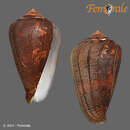fr
noms dans le fil d’Ariane


Der Hermelinschwanz bzw. die Hermelinschwanz-Kegelschnecke (Conus ermineus) ist eine Schnecke aus der Familie der Kegelschnecken (Gattung Conus). Es ist die einzige fischfressende Conus-Art des Atlantiks.
Nach der Erstbeschreibung von Conus ermineus durch Ignaz von Born hat „die birnförmige rothgelbe Schale [...] am Grunde erhabene punktirte Streife, und schneeweiße Querbänder. Die Schale ist birnförmig, und glatt, am Grunde in die Quere gestreifet, und auf den erhabenen Streifen mit Körnern besezet. Der Schnirkel [das Gewinde] ist kegelförmig. Die Gewinde [Umgänge] glatt und etwas flach. Die Farbe rothgelb an dem Schnirkel weißgefleckt, und um den Leib mit zweyen unterbrochenen Querbändern umgeben. Die erhabenen Punkte, oder Körner sind weiß.“[1]
Das Gehäuse erreicht bei ausgewachsenen Schnecken eine Länge von bis zu 10,3 mm.[2]
Der Hermelinschwanz tritt in der Karibik und der Atlantikküste Amerikas auf, so gibt es Funde aus den USA (Louisiana, Texas), Mexiko, Costa Rica, Kolumbien, Venezuela, Puerto Rico, St. Vincent und Surinam.[3]
Hermelinschwanz-Kegelschnecken leben an der Küste bis 100 m Tiefe.[2]
Als einzige Kegelschnecke des Atlantiks frisst Conus ermineus Fische.[4] Die Beute wird zunächst mit dem giftigen Radulazahn harpuniert und dann innerhalb weniger Sekunden verschluckt.[5] Gelegentlich frisst diese Kegelschnecke offenbar auch Kopffüßer; so wurde im Darm eines Conus ermineus der Schnabel eines Kraken gefunden.[6]
Der Hermelinschwanz bzw. die Hermelinschwanz-Kegelschnecke (Conus ermineus) ist eine Schnecke aus der Familie der Kegelschnecken (Gattung Conus). Es ist die einzige fischfressende Conus-Art des Atlantiks.
Conus ermineus, common name the turtle cone, is a species of sea snail, a marine gastropod mollusk in the family Conidae, the cone snails and their allies.[1]
Like all species within the genus Conus, these snails are predatory and venomous. They are capable of "stinging" humans, therefore live ones should be handled carefully or not at all.
This species occurs in the Caribbean Sea and the Gulf of Mexico to South America; in the Atlantic Ocean off West Africa and the Cape Verdes; in the Indian Ocean off Tanzania.
The maximum recorded shell length is 103 mm.[2]
Conantokin-E is a toxin derived from the venom of Conus ermineus.
It is a fishing eating species. Utilizes specialized hollow harpoon like radula tooth to harpoon small fish and paralyze them with venom to facilitate swallowing.
Minimum recorded depth is 0 m.[2] Maximum recorded depth is 101 m.[2]
Conus ermineus is a venomous species and capable of stinging humans, so it should be treated with caution. A delta-conotoxin (delta-EVIA) isolated from the venom of C. ermineus inhibits the inactivation of vertebrate Na + neural channels.[3]
Conus ermineus, common name the turtle cone, is a species of sea snail, a marine gastropod mollusk in the family Conidae, the cone snails and their allies.
Like all species within the genus Conus, these snails are predatory and venomous. They are capable of "stinging" humans, therefore live ones should be handled carefully or not at all.
 Conus ermineus Born, I. von, 1778
Conus ermineus Born, I. von, 1778
Conus ermineus is een in zee levende slakkensoort uit het geslacht Conus. De slak behoort tot de familie Conidae. Conus ermineus werd in 1778 beschreven door Born.[1] Net zoals alle soorten binnen het geslacht Conus zijn deze slakken roofzuchtig en giftig. Zij bezitten een harpoenachtige structuur waarmee ze hun prooi kunnen steken en verlammen.[2]
Conus ermineus é uma espécie de gastrópode do gênero Conus, pertencente à família Conidae. [1]
Conus ermineus là một loài ốc biển, là động vật thân mềm chân bụng sống ở biển trong họ Conidae, họ ốc cối.[1]
Giống như tất cả các loài thuộc chi Conus, chúng là loài săn mồi và có nọc độc. Chúng có khả năng "đốt" con người, do vậy khi cầm chúng phải hết sức cẩn thận.
Chiều dài tối đa của vỏ ốc được ghi nhận là 103 mm.[2]
Độ sâu tối thiểu được ghi nhận là 0 m.[2] Độ sâu tối đa được ghi nhận là 101 m.[2]
Phương tiện liên quan tới Conus ermineus tại Wikimedia Commons
Conus ermineus là một loài ốc biển, là động vật thân mềm chân bụng sống ở biển trong họ Conidae, họ ốc cối.
Giống như tất cả các loài thuộc chi Conus, chúng là loài săn mồi và có nọc độc. Chúng có khả năng "đốt" con người, do vậy khi cầm chúng phải hết sức cẩn thận.